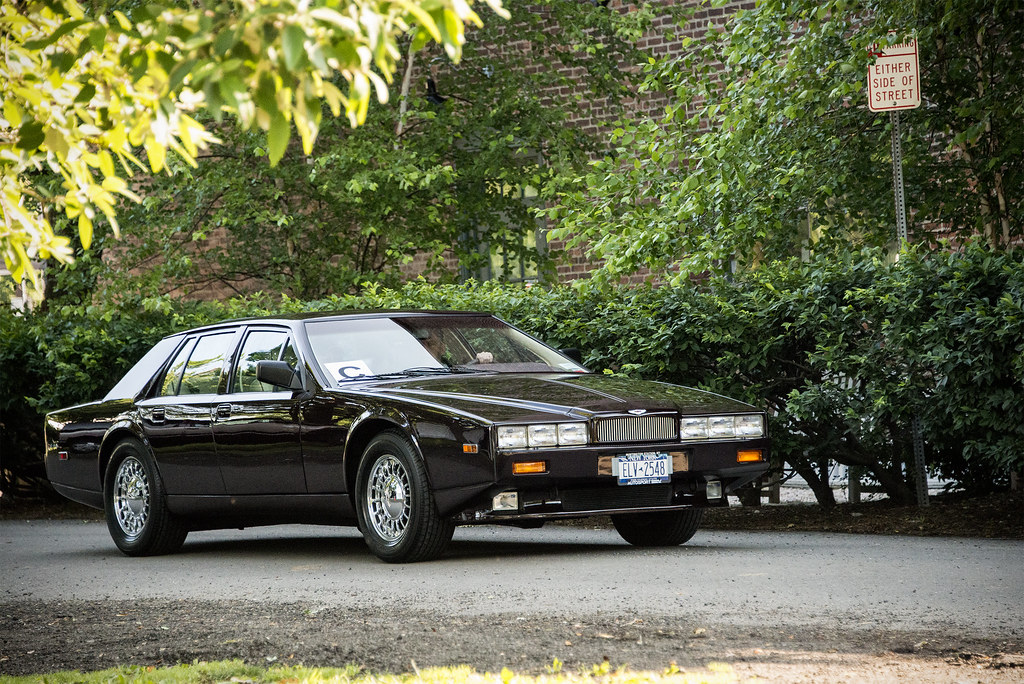
Probably one of the greatest missed opportunities of British
sedans of the 1970s, bespoke sedans anyway, was the Aston Martin Lagonda.
Designed by William Towns using nothing but a ruler, the sedan once again
resurrected the Lagonda nameplate following an absence of a few years.
Cognoscenti will recall that DB (I’m on an initials-only basis with Mr. Brown)
had brought Lagonda out of hibernation in 1961, building and with some effort
selling 55 Lagonda Rapide saloons, mostly to his friends. That previous effort
was also marred by slightly off-putting styling, at least as the front fascia
was concerned. The construction and sales of the 1962-1964 Rapides caused quite
a bit of internal strife within Aston Martin, putting a strain on its
production capacity, and assured that Lagonda would not return again for a
while.
The next attempt to revive Lagonda occurred in 1974, when
the company was under William Wilson’s ownership. A total of seven Series 1
sedans based largely on the DBS model were built, one of them with a DBS-style
front fascia, which was quite handsome. Had there been more built, badged
perhaps as AMs, I’d imagine they would have quite a following today.
The very next effort by Aston Martin to market a luxury
sedan brings us to the William Towns’ Lagonda, which was quite well received
when it premiered, despite stalling on the way to the show podium. Even
though it premiered merely 2 years after the Series 1 cars were built, it
shared very little with the Series 1 in terms of mechanicals. Prices were high,
but production was slow and difficult. Deliveries of ordered cars took quite a
long time, as only one or two cars were completed each week, and initial
reliability was not all that great. In fact, only 16 cars were completed during
the first year of “production.” The Lagondas were generally cheaper than Silver
Spirits or Corniches, but their design was polarizing, to say the least.
Even though sales picked up during the 1980s, owing largely
to the Middle Eastern market, the car’s prices ballooned to £50,000, up from
around £33,000. Even though the car was credited with saving Aston Martin in
the 1980s, production once again diverted efforts from expanding the lineup of
coupes and convertibles. By the mid-1980s fashion had finally caught up with
the design of the Lagonda, and complicated (and often malfunctionning)
instruments had left a mark. Efforts were made to soften-up the design, but
there was only so much that could have been done without changing the basic
structure of the greenhouse. Production continued until 1989, by which time the
Lagonda’s instruments were more or less sorted out.
Hindsight is always 20/20, but could things have turned out
better if AM had chosen to go with a more traditional design, one that eschewed
Star Trek internal controls and focused on the passenger experience, in the
spirit of the Rolls-Royce Silver Spirit? Don’t get me wrong, the William Towns’
Lagonda is comfy enough on the inside, if you fit into the back seat, that is.
But a chauffeured limo it isn’t, and it was never really planned as such.
Instead, AM went for a sportier saloon that brimmed with futuristic technology
(that rarely worked). But was the sports sedan approach the best way to go from
the start, or should Aston have made a chunkier cruiser that could have
attacked Crewe’s barges from the flanks?
source: http://www.classicblog.net/2012/06/12/the-lagonda-now-with-even-more-hindsight/http://www.fzrestoration.com
No comments:
Post a Comment